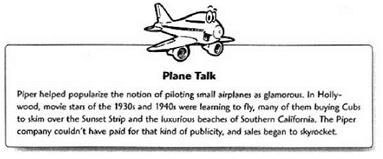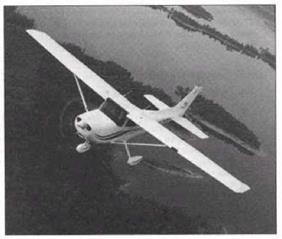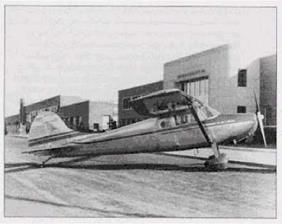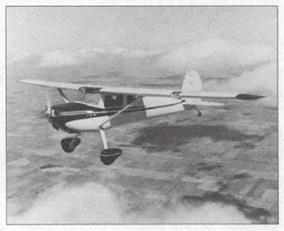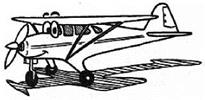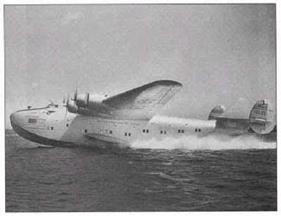When “Hogs” Fly
No description of general aviation airplanes would be complete without including two other makes of airplane, each with their own rabidly loyal following: Beechcraft and Mooney. Both Beechcrafts and Mooneys are as strong as army tanks and blessed with enough power to outpace most other single-engine competitors. Owners of Beechcrafts and Mooneys both congregate in their own tight-knit clubs, and they identify with their airplanes with as much enthusiasm as Harley-Davidson owners do with their “hogs.” In fact, scores of Mooney owners make a yearly pilgrimage to the Mooney factory in Kerrville, Texas, where they eat, drink, and tell flying stories, most of which center on their beloved airplanes.
|
By the Book |
Spoilers are panels or plates that manufacturers install on the top surface of an airplane’s wings to "spoil" the lift and allow a pilot to descend for landing or to slow down quickly in flight.
(We’ll go into lift and the other forces of flight in Chapter 8.
"How Airplanes Ffy, Part 2: The Aerodynamics of Flight.") If you’ve watched an airliner’s wings during a descent and landing, you may have noticed metal plates located about half-way between the front and back edges of the wing rising into the airflow. Those are the spoilers, and when they move, they indicate that the pilot is trying to steepen his descent or slow down.
_____________________ _____________
Mooneys are a famously well-designed family of planes that manage to squeeze more speed out of each horsepower than virtually any other mass-produced plane. The credit goes to the company’s designers, who obsess over every detail in trying to make their planes’ skin smoother or finding a more aerodynamic way to hide a piece of equipment. Mooneys are so sleek, in fact, that they don’t seem to want to come back to earth once they’re aloft. Pilots have found them hard to slow down for landing, so designers have installed spoilers on the wings.
The Mooney M20 is among the most popular models the company has produced. M20s are plentiful in the used-airplane market, and, with a cruise speed of almost 200 m. p.h. from a modest, 200 horsepower engine, are one of the best performers among the inexpensive small planes.
In the years since the M20 was first manufactured in the mid-1950s, Mooney has unveiled model after model of faster, sleeker airplanes, each with the Mooney signature vertical stabilizer that juts forward slightly as though eager to go even faster.
|
On Course I certainly don’t mean to ignore some of the other spectacular high-wing models, such as Stinsons. Though far less common than either Piper or Cessna, Stinsons have a wildly loyal group of followers. Include me in the ranks of Stinson lovers! |
|
On Course If you want to move into the passionate heart of sport flying, join a flying association. Owners of Beechcraft Bonanzas, the most popular plane Beechcraft makes, can join the American Bonanza Society; Mooney owners can join the Mooney Aircraft Pilots’ Association; and owners of my beloved Cessna 170 can join the International Cessna 170 Association. Flyers who don’t own their own planes can still join most clubs. Ask anybody at I your local airport how to join. |
Beechcraft’s signature model is the high-performance, single-engine Bonanza. Bonanzas are a bit more barrelchested than Mooneys, but they’re just about as fast and they provide passengers and pilots alike with plenty of room to spread out. (Mooneys are notorious for their tight, uncomfortable cabin, although it is that narrow waist that helps the planes fly so fast. It’s your choice: speed or luxury?) Beechcrafts are put together so sturdily that closing the cabin door sounds like closing a bank vault.
The Bonanza has been manufactured with two different styles of tail. In one design, the tail retains the familiar combination of horizontal and vertical surfaces, which pilots call, appropriately, the horizontal and vertical stabilizers. (We’ll talk about what these surfaces do in the next chapter.) But Beechcraft turned that familiar model on its ear in 1945 when it first flew a V-tail model. Like its name implies, the V-tail Bonanza has a tail design that eliminates the traditional horizontal and vertical stabilizers and replaces them with a V-shaped pair of surfaces called “ruddervators.”
Beechcraft designers were criticized for the unconventional design, but the company was convinced the idea would catch on with the flying public, and it did. The V- tail Bonanza is one of the most strikingly beautiful planes you’ll ever see, and thanks to a recent “patch” that cured some structural weakness the design suffered from, it is just as safe and fun to fly as any other airplane in the sky.
If price is no object, the best single-engine airplane, to my taste, at least, is the robust, speedy, and reliable Cessna 210 Centurion. I’ve already explained my preference for the high wings and the easy access to Cessnas, and add to those factors the 310 horsepower engine and a hefty list of extras and luxuries, and you have a fine airplane. Passengers like the large Cessnas for their generous leg room and, it bears repeating, an excellent view.
It’s possible to pay over $200,000 for a mint-condition used Centurion—Cessna doesn’t make new Centurions right now—but some well-maintained 210s are also being sold for as little as $50,000.















